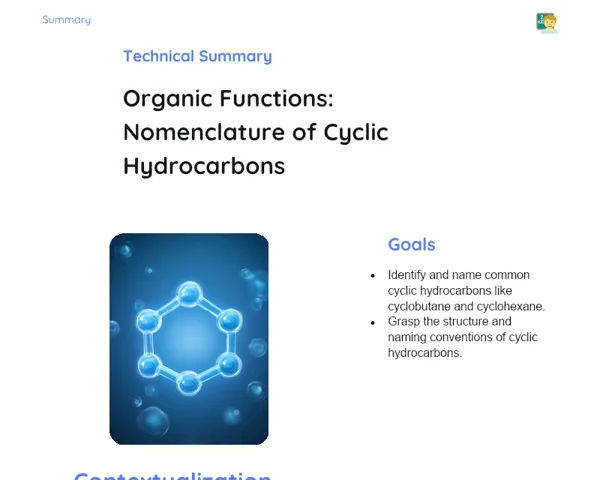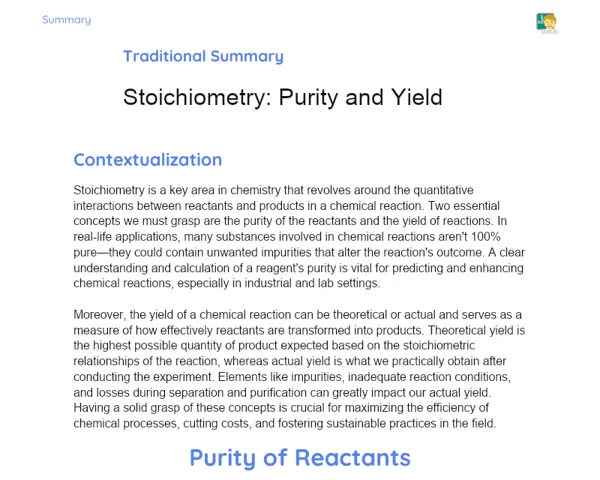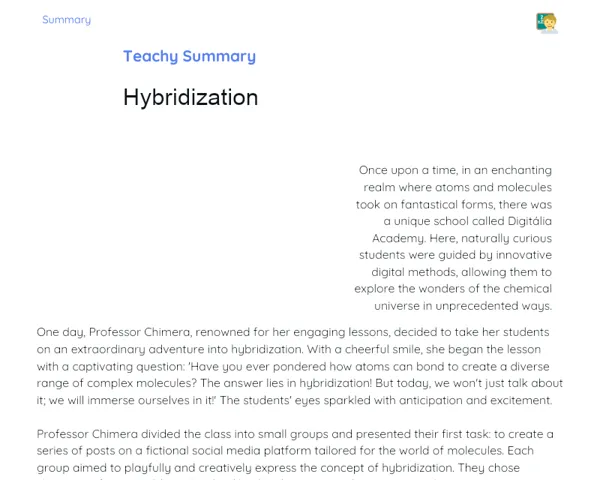Socioemotional Summary Conclusion
Goals
1. Understand what a nuclear reaction is and identify the emitted particles and radiations, such as alpha, beta, and gamma.
2. Differentiate between nuclear fission and fusion, recognizing their applications and real-world implications.
Contextualization
Did you know that the energy that powers our cities and charges our gadgets can originate from nuclear reactions? These reactions take place at the core of atoms and have the potential to convert tiny amounts of matter into enormous amounts of energy! From generating electricity in nuclear power plants to the twinkling stars we see at night, everything is linked to nuclear reactions. Let's dive into this intriguing domain and comprehend how these reactions affect our world!
Exercising Your Knowledge
Alpha Radiation (α)
Alpha radiation is made up of high-energy particles, consisting of 2 protons and 2 neutrons. Although it is one of the heaviest types of radiation and has low penetration power, it can be quite harmful if ingested or inhaled. Think of alpha radiation like a solid cannonball – it doesn't travel far, but when it hits, it makes a noticeable impact.
-
Low Penetration Ability: Alpha radiation can be easily stopped by materials like a sheet of paper or even human skin.
-
High Energy: Even though it doesn't penetrate deeply, it has high energy that can cause significant damage to living cells if the particles are ingested or inhaled.
-
Safety: Because of its low penetration ability, handling it requires simple precautions like wearing gloves and masks.
Beta Radiation (β)
Beta radiation consists of electrons or positrons emitted from the nucleus during a nuclear reaction. These particles are lighter than alpha particles and can penetrate materials like paper but are blocked by aluminum. Picture beta radiation as an arrow – lighter, quicker, and capable of traversing greater distances accurately.
-
Moderate Penetration Ability: Beta radiation can penetrate lighter materials like paper and clothing but is blocked by a sheet of aluminum.
-
Medical Applications: It is utilized in radiation therapy for cancer treatment, thanks to its ability to penetrate organic tissues.
-
Potential Dangers: Care must be taken while working with materials emitting beta radiation, as it can lead to burns and cellular damage if not handled properly.
Gamma Radiation (γ)
Gamma radiation consists of high-energy electromagnetic waves that carry no mass or charge. It is the most penetrating form of radiation capable of passing through dense materials like lead and concrete. Imagine gamma radiation as a very powerful X-ray – invisible and able to pass through nearly anything in its way.
-
High Penetration Ability: Gamma rays can easily move through light and moderate materials, being obstructed only by very dense substances like lead or concrete.
-
Use in Medicine: They are widely used in imaging diagnostics and cancer therapies due to their capacity to penetrate deep tissues.
-
Safety: Given its high penetration power, it is crucial to employ dense barriers (like lead) for protection when dealing with gamma radiation sources.
Nuclear Fission
Nuclear fission refers to the process of splitting a heavy atomic nucleus into two smaller nuclei, resulting in a massive release of energy. This process is commonly used in nuclear power plants to produce electricity. Think of it as a bowling ball hitting a set of pins – the ball represents a neutron, and the pins represent the nucleus of a heavy atom. When the ball strikes, the pins scatter, releasing energy.
-
Nuclear Splitting: A heavy nucleus, such as Uranium-235, is struck by a neutron, leading to two smaller nuclei and additional neutrons.
-
Energy Release: Fission generates a colossal amount of energy, which is harnessed in nuclear power plants for electricity generation.
-
Risks and Challenges: It carries significant risks, including the potential for nuclear accidents and the generation of radioactive waste.
Nuclear Fusion
Nuclear fusion is the process where two light nuclei merge to form a heavier nucleus, releasing an enormous amount of energy in the process. This is what's happening in the Sun, keeping it bright and hot. Picture fusion as the act of joining two balls of clay to create a larger one—releasing energy while you do it.
-
Nucleus Combination: Light nuclei, such as those of hydrogen, fuse to form a heavier nucleus like helium.
-
Clean Energy: Fusion could potentially serve as a clean and nearly infinite energy source, as its primary fuels are plentiful.
-
Technical Challenges: The technology required to control and sustain fusion reactions is still being developed, posing challenges for scientists and engineers.
Key Terms
-
Nuclear Reaction: A process that alters the nucleus of an atom, leading to the emission of radiation or subatomic particles.
-
Alpha Radiation (α): A particle made of 2 protons and 2 neutrons; has low penetrating power.
-
Beta Radiation (β): A particle, either an electron or positron, emitted by the nucleus; has moderate penetrating ability.
-
Gamma Radiation (γ): High-energy electromagnetic waves, with no mass or charge, possessing high penetration power.
-
Nuclear Fission: The process of splitting a heavy atomic nucleus into smaller nuclei, releasing energy.
-
Nuclear Fusion: The process whereby two light nuclei combine to form a heavier nucleus, releasing energy.
For Reflection
-
What are your thoughts knowing that the energy we use can stem from nuclear reactions, with their associated risks and benefits? How do you view the safe application of nuclear energy?
-
Consider the emotional and social ramifications of nuclear accidents on nearby communities. In your opinion, how do such incidents affect the mental health and well-being of the individuals involved?
-
Reflecting on nuclear fusion as a potential source of clean energy, how optimistic do you feel about the future of global energy? What emotions and hopes come to mind when envisioning a future with clean and sustainable energy?
Important Conclusions
-
Nuclear reactions occur within the nuclei of atoms, changing their structure and releasing large amounts of energy.
-
There are three primary types of radiation emitted during nuclear reactions: alpha, beta, and gamma radiation, each with distinct characteristics and penetration abilities.
-
Nuclear fission involves splitting a heavy atomic nucleus into smaller nuclei, releasing energy, while nuclear fusion combines light nuclei to form a heavier nucleus, also releasing energy.
-
Gaining an understanding of nuclear reactions and their applications can assist us in making informed choices about the usage of nuclear energy and its consequences in our world.
Impacts on Society
Nuclear reactions significantly influence our society today. Nuclear energy is a vital source of electricity in many countries, substituting fossil fuels and aiding in the reduction of greenhouse gas emissions. However, instances of nuclear disasters, like Chernobyl and Fukushima, reveal the associated risks and devastating outcomes. These events not only harmed the environment but also caused severe health problems and displaced entire communities, adversely affecting the mental health and well-being of those affected.
Furthermore, nuclear fusion, though still being explored, holds the promise of a clean and nearly boundless energy source. This perspective fosters hope for a more sustainable future. Nevertheless, overcoming the technical challenges involved in controlling and sustaining fusion reactions remains a significant hurdle, demanding creativity and determination. Nuclear fusion could potentially revolutionize our energy production, offering a solution to the global energy crisis while contributing to a cleaner and healthier planet.
Dealing with Emotions
While at home, take some time to reflect on your feelings about studying nuclear reactions and their applications. Use the RULER method for guidance: First, recognize your emotions – do you feel anxious, curious, or uncertain? Next, seek to understand the causes of these feelings – is it due to the complexity of the topic or concerns about potential risks? Correctly label these emotions and express them effectively, perhaps by journaling or discussing with a trusted individual. Lastly, think of techniques to regulate these emotions. Simple practices such as deep breathing or taking breaks to engage in enjoyable activities may help. This reflection will assist you in managing your feelings and better preparing you to tackle challenging subjects like nuclear reactions.
Study Tips
-
Go through your notes and diagrams from class to reinforce your grasp of the concepts.
-
Watch videos and documentaries related to nuclear reactions and energy production. This can aid in visualizing and comprehending theoretical processes.
-
Participate in online forums and discussion groups to exchange ideas and seek clarification from peers and experts on the subject.



